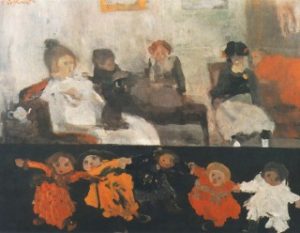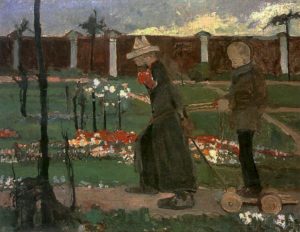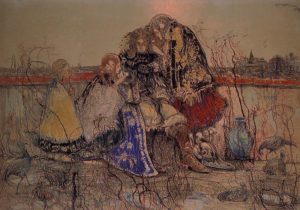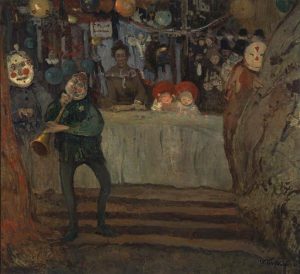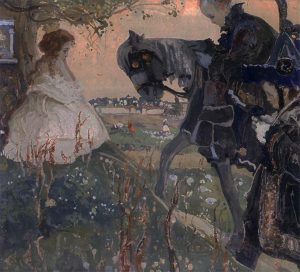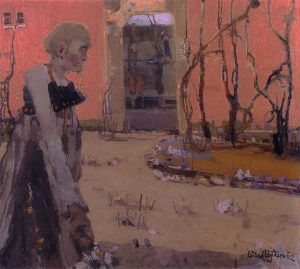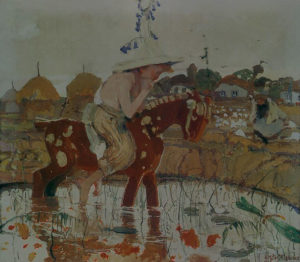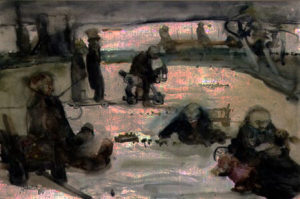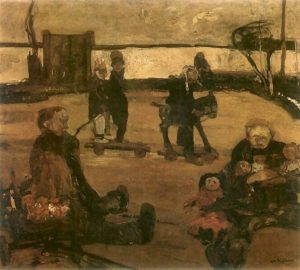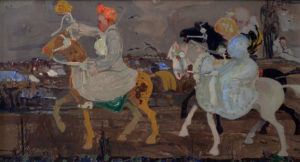The artist was born on the 29th of December in 1879 in Warsaw
1879 - 1909
Witold Wojtkiewicz
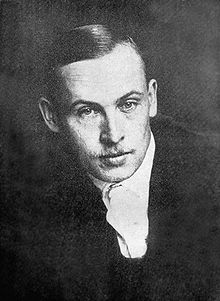
description
Polish artist, draftsman, graphic artist and book illustrator. He was born in the family of a cashier of the bank, was one of eleven children. Witold was interested in art from childhood.
He also wrote satirical texts for «Kolets» magazine, actively participated in the activity of “Green Balloon” cabaret, in the publication of elite magazine “Liberum Veto” under the pseudonym “Count Voitek”. Was engaged in book graphics. He created a collection of travesty-retellings of the works by the most respected artists, among whom there were Olga Boznanska, Jan Stanislavsky and Leon Vichulkovsky. Being affected by the spirit of fantasy, Wojtkiewicz was able to portray the imaginary world as real. He depicted scenes with children inspired by fairy-tale plots (“Kidnapping of the princess”). Burlesque scenes in the style of Toulouse-Lautrec are, at the same time, more often not deprived of lyricism.
Not surviving by his thirtieth birthday, the artist managed to leave a legacy that preceded the development of Expressionism and Surrealism.
In 1976, a large retrospective exhibition of the artist was held at the Polish National Museum of Krakow.
Key ideas:
– In the early stages of the work, the painting with an illustrative, satirical and political background dominated.
– Later, in graphic works, there was an appearance of “metaphysics of sex”, fascinated by Polish bohemia following Stanislav Przybyshevsky.
– The thesis of the philosophy of human existence, which obeys the all-embracing power of erotica, is reflected not only in graphics, but also in painting.
– Imagination circled around the topics transmitting the real episodes of drama (“Demonstration”) and melodrama. Bearers of symbolic value are masks, dolls-puppets, jugglers, which sometimes multiply, depicting the crowd in its compact form.
– A distinguishing feature of the Polish master is in the ability to convey a certain suspended state, when the objects of the image lose the dynamics of the narrative, changing into mood symbols.
– In the series of ceremonies, the court rituals become the leitmotif: the rite is built into an idyllic landscape or occurs in closed palace interiors. The artist uses complex ornamentation, painting rich patterns of precious fabrics, elaborate and elegant hats, large crowns that adorn too small heads. The views of the characters are immersed in themselves, their thoughts or are narcissistically aimed at their reflection.
– In the field of painting technique, Wojtkiewicz acted as an experimenter. He used oil paints for the first layer, later superimposed tempera. This allowed the artist to get a matte color tone, which conveyed nostalgic moods. This technique can be traced in portraits: the artist did not manage to create many works of this genre, but depicted important personalities, for example, writer B. Rachinsky, artist Maximilian Rosen, and others.
1879
1898
1901
1902
1903 - 1904
1905
1906
1907
1908
1909
The birth of the artist
Entered the Gerson Institute
Entered the Gerson Institute (Warsaw School of Drawing).
Attended classes at the Academy of Arts in Krakow
Attended classes at the Academy of Arts in Krakow.
Joseph began his studies at the St. Petersburg Academy
At the invitation of his uncle, Joseph began his studies at the St. Petersburg Academy, but almost immediately left it and returned to Warsaw.
Worked as an illustrator
Visited the Cracow Academy of Fine Arts, where he was a student of L. Wichulkowski; worked as an illustrator in the Krakow weekly edition “Liberum Veto”.
He was an eyewitness of the Warsaw Uprising
He was an eyewitness of the Warsaw Uprising, which was reflected in his work; became a member of the commonwealth of artists “Grupa Pięciu” (The group of five), created by L. Gottlieb and others.
Participated in an exhibition in Berlin
Graduated from the Academy; participated in an exhibition in Berlin, exhibited works in the exposition of the exhibition of the Group of Five.
The exhibition of his works in the Parisian gallery of Druet
André Gide, being interested in Wojtkiewicz’s work, organized an exhibition of his works in the Parisian gallery of Druet (Galerie Druet) and wrote the foreword for the catalog.
"Sztuka"
Joined the Society of Polish Artists “Sztuka”, gained popularity in Poland and Austria; participated in the exhibition of “Zero group”.
The death of the artist
The artist died on the 14th of June in 1909 in Warsaw.

